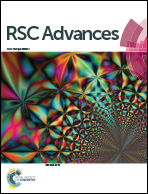Synthetic approaches and in vitro cytotoxic evaluation of 2-acyl-3-(3,4,5-trimethoxyanilino)-1,4-naphthoquinones
Abstract
2-Acyl-1,4-naphthoquinones react with 3,4,5-trimethoxyaniline, under aerobic conditions, to give benzophenanthridinequinone, benzocarbazole and 2-acyl-3-(3,4,5-trimethoxyanilino)-1,4-naphthoquinone derivatives. The formation of the heterocyclic compounds is discussed in terms of the ring closure of C–C Michael type adduct intermediates through two alternative N–C-bond formations. The propensity of the substrates to undergo preferential C–C instead of C–N bond formation and the further heterocyclization of the C–C Michael type adduct intermediates is rationalized by using product stability parameters assessed by DFT calculations. Preliminary results are reported on a convenient access towards 2-acyl-3-(3,4,5-trimethoxyanilino)-1,4-naphthoquinones from 2-acylnaphthoquinones and their cytotoxic activities on cancer cells.



 Please wait while we load your content...
Please wait while we load your content...